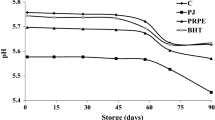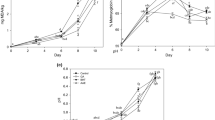Abstract
Lipid oxidation-induced quality problems can be minimized with the use of natural antioxidants. The antioxidant potential of pink guava pulp (PGP) was evaluated at different levels (0%; C, 5.0%; T-1, 7.5%; T-2 and 10.0%; T-3) in the raw pork emulsion during refrigerated storage of 9 days under aerobic packaging. Lycopene and β-carotene contents increased (P < 0.05) with PGP levels. The redness (a*) increased (P < 0.05), whereas L*decreased (P < 0.05) with the incorporation of PGP. The visual colour and odour scores were greater (P < 0.05) in PGP-treated products than control. Percent metmyoglobin formation was greater (P < 0.05) in the control than PGP-treated products, and increased (P < 0.05) during storage in all the treatments. Overall, peroxide value, thiobarbituric acid reactive substances and free fatty acid values were lower (P < 0.05) in PGP-treated raw emulsion than control throughout storage period. Our results indicated that pink guava pulp can be utilized as antioxidants in raw pork products to minimize lipid oxidation, off-odour development, and surface discolouration.
Similar content being viewed by others
References
Aguirrezabal MM, Mateo MC, Dominguez MC, Zumalacarregui JM (2000) The effect of paprika, garlic and salt on rancidity in dry sausages. Meat Sci 54:77–81
Ahn J, Grun IU, Mustapha A (2004) Antimicrobial and antioxidant activities of natural extracts in vitro and in ground beef. J Food Protect 67:148–155
AMSA (1991) Guidelines for meat colour evaluation. American Meat Science Association, Chicago
AOAC (1995) Official methods of analysis, 16th edn. Association of Official Analytical Chemists International, Arlington
Bashir HA, AbuGoukh ABA (2003) Compositional changes during guava fruit ripening. Food Chem 80:557–563
Calvo MM, Garcia ML, Selgas MD (2008) Dry fermented sausages enriched with lycopene from tomato peel. Meat Sci 80:167–172
Candogan K (2002) The effect of tomato paste on some quality characteristics of beef patties during refrigerated storage. Eur Food Res Technol 215:305–309
de Pablo B, Asensio MA, Sanz B, Ordonez JA (1989) The D (−) lactic acid and acetoin/dyacetyl as potential indicators of the microbial quality of vacuum packaged pork and meat products. J Appl Bacteriol 66:185–190
DiMasico P, Kaiser S, Sies H (1989) Lycopene as the most efficient biological carotenoid singlet oxygen quencher. Arch Biochem Biophys 274:532–538
Escrig AJ, Rincon M, Pulido R, Calixto FS (2001) Guava fruit (Psidium guajava) as a new source of antioxidant dietary fiber. J Agric Food Chem 49:5489–5493
Eyiler E, Oztan A (2011) Production of frankfurters with tomato powder as a natural additive. LWT-Food Sci Technol 44:307–311
Faustman C, Sun Q, Mancini R, Suman SP (2010) Myoglobin and lipid oxidation interactions: mechanistic bases and control. Meat Sci 86:86–94
Fellenberg MA, Speisky H (2006) Antioxidants: their effects on broiler oxidative stress and its meat oxidative stability. Poult Sci J 62:53–69
Fish WW, Perkins-Veazie P, Collins JK (2002) A quantitative assay for lycopene that utilizes reduced volumes of organic solvents. J Food Compos Anal 15:309–317
García ML, Calvo MM, Selgas MD (2009) Beef hamburgers enriched in lycopene using dry tomato peel as an ingredient. Meat Sci 83:45–49
Giroux M, Ouattara B, Refsah R, Smoragiewicz W, Saucier L, Lacroix M (2001) Combined effect of ascorbic acid and gamma irradiation on microbial and sensorial characteristics of beef patties during refrigerated storage. J Agric Food Chem 49:919–925
Greene BE, Cumuze TH (1982) Relationship between TBA numbers and inexperienced panelists assessments of oxidized flavour in cooked beef. J Food Sci 47:52–58
Han J, Rhee KS (2005) Antioxidant properties of selected oriental non-culinary/nutraceutical herb extracts as evaluated in raw and cooked meat. Meat Sci 70:25–33
Hassan O, Fan LS (2005) The antioxidative potential of polyphenol extract from cocoa leaves on mechanically deboned chicken meat (MDCM). LWT-Food Sci Technol 38:315–321
Jay JM (1964) Beef microbial quality determined by extract release volume (ERV). Food Technol 18:1637–1641
Koniecko R (1979) Handbook for meat chemists. Avery, Wayne, pp 53–55
Krzywicki K (1979) Assessment of relative content of myoglobin, oxymyoglobin and metmyoglobin at the surface of meat. Meat Sci 3:1–10
Kumar M, Sharma BD (2004) The storage stability and textural, physico-chemical and sensory quality of low-fat ground pork patties with carrageenan as fat replacer. Int J Food Sci Technol 39:31–42
Mercadante AZ, Steck A, Pfander H (1999) Carotenoids from guava (Psidium guajava L): isolation and structure elucidation. J Agric Food Chem 47:145–151
Miean KH, Mohamed S (2001) Flavonoid (myricetin, quercetin, kaempferol, luteolin, and apigenin) content of edible tropical plants. J Agric Food Chem 49:3106–3112
Misra K, Seshadri TR (1968) Chemical components of the fruits of Psidium guajava. Phytochemistry 7:641–645
Negi PS, Roy SK (2003) Changes in β-carotene and ascorbic acid content of fresh amaranth and fenugreek leaves during storage by low cost technique. Plant Foods Hum Nutr 58:225–230
Osterlie M, Lerfall J (2005) Lycopene from tomato products added minced meat: Effect on storage quality and colour. Food Res Int 38:925–929
Padula M, Rodryuez Amaya DB (1986) Carotenoids and assessment of vitamin A of Brasilian Guava (Pisidium guajava L). Food Chem 20:11–19
Rey AI, Hopia A, Kivikari R, Kahkonen M (2005) Use of natural food/plant extracts: cloudberry (Rubus chamaemorus), beetroot (Beta vulgaris) or willow herb (Epilobium angustifolium) to reduce lipid oxidation of cooked pork patties. LWT-Food Sci Technol 38:363–370
Sallam KI, Ishioroshi M, Samejima K (2004) Antioxidant and antimicrobial effects of garlic in chicken sausage. Lebensm wiss Technol 37:849–855
Selgas MD, Garcia ML, Calvo MM (2009) Effects of irradiation and storage on the physico-chemical and sensory properties of hamburgers enriched with lycopene. Int J Food Sci Technol 44:1983–1989
Shelef LA, Jay JM (1970) Use of a titrimetric method to assess the bacterial spoilage of fresh beef. Appl Microbiol 19:902–905
Shi J, Maguer ML (2000) Lycopene in tomatoes: chemical and physical properties affected by food processing. Crit Rev Food Sci Nutri 40:1–42
Trout GR (1989) Variations in myoglobin denaturation and colour of cooked beef, pork and turkey meat as influenced by pH, sodium chloride, sodium tripolyphosphate and cooking temperature. J Food Sci 54:536–540
Valencia I, Ansonera D, Astiasaran I (2007) Development of dry fermented sausages rich in docosahexaenoic acid with oil from the microalgae Schizochytrium sp: influence on nutritional properties, sensorial quality and oxidation stability. Food Chem 104:1087–1096
Witte VC, Krause GF, Bailey ME (1970) A new extraction method for determining 2-Thiobarbituric acid values of pork beef during storage. J Food Sci 35:582–585
Author information
Authors and Affiliations
Corresponding author
Rights and permissions
About this article
Cite this article
Joseph, S., Chatli, M.K., Biswas, A.K. et al. Efficacy of pink guava pulp as an antioxidant in raw pork emulsion. J Food Sci Technol 51, 1492–1500 (2014). https://doi.org/10.1007/s13197-012-0668-1
Revised:
Accepted:
Published:
Issue Date:
DOI: https://doi.org/10.1007/s13197-012-0668-1




